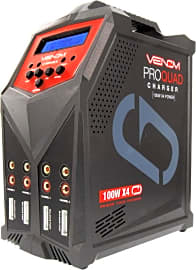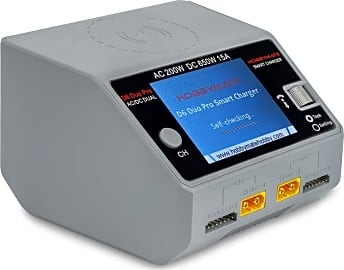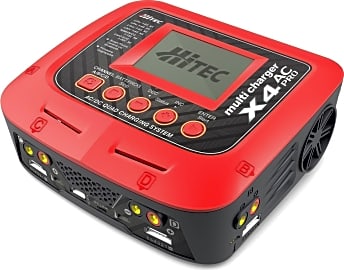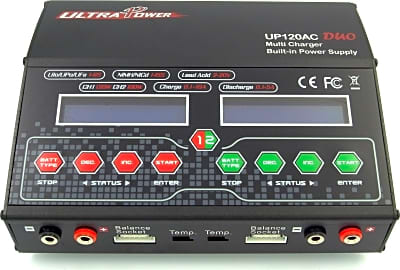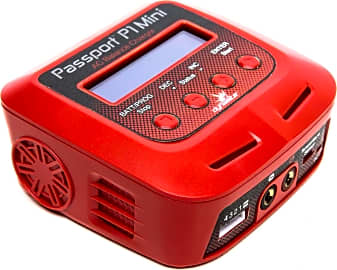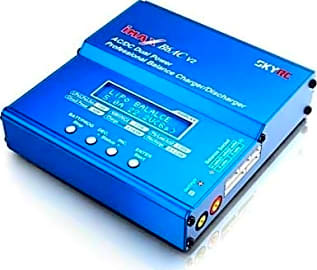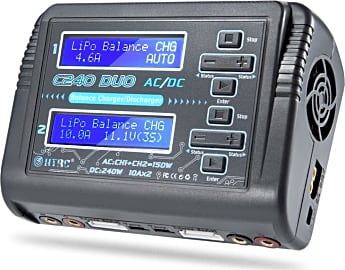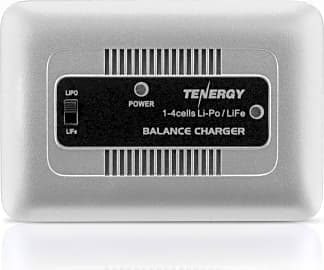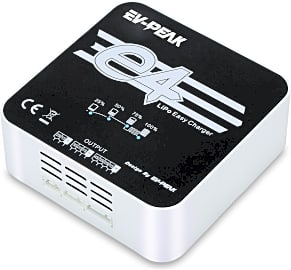The 10 Best LiPo Chargers

This wiki has been updated 39 times since it was first published in February of 2017. Whether you're an RC hobbyist who's always on the go or you're looking to get the most out of all your battery-powered accessories, one of these LiPo chargers will be a worthwhile investment. We've included models that offer intuitive digital menu interfaces, multiple connection ports, integrated cooling systems, and a wide range of compatibility with various battery types. When users buy our independently chosen editorial selections, we may earn commissions to help fund the Wiki.
Editor's Notes
November 10, 2020:
In this update, the we added in the full-featured Tenergy T180, which takes a prominent spot on the list. Unlike many others, it’s got a comprehensive touchscreen LCD that keeps you apprised of its status in detail, and lets you change the settings with the handy stylus that comes with it. It stays cool to the touch, thanks to an internal cooling fan and all-metal housing. It’s got protection against over-voltage, overheating, over-current, short circuits, and reverse polarity. It’s also equipped with functions like balancing, fast charging, cyclic charging, discharging, and data storage. The compact housing helps ensure it’ll fit nicely in your field box. Another model from Tenergy joins the list today, which is the Tenergy TN267. It’s made with convenience and portability in mind, which a compact size and quick plug-and-play design. It comes in handy for on-the-go use, making it a good choice for owners of airsoft guns or RC cars and helicopters. Be aware that with the portability and small size come less comprehensive status indicators, however. One light lets you know it’s powered on, and the other alerts you when the battery is fully charged. It works with both LiPo and LiFe batteries, and you just have to flip a switch to let it know which of the two types you need to charge.
We also replaced the Venom Pro Duo with the Venom Pro Quad, the latter of which can balance charge up to four batteries at a time and doesn’t take up significantly more space than the Duo. Its vertical shape means it won’t take up much of your precious desk or countertop space. It’s got a user-friendly push-button interface with a bright, backlit LCD. With it, you’ll receive leads for charging Traxxas, Fat Shark, and others. It’s from a company that started up in a garage almost two decades ago and since then has emerged as an industry leader that focuses exclusively on rechargeable batteries and battery chargers.
For safety’s sake, never attempt to charge a faulty or damaged battery, or to use your charger with a battery that’s not compatible with it. Go with a charger model that provides over-charge protection, as well as LED indicators or an LCD that keeps you apprised how the charger is functioning.
August 15, 2019:
We've beefed up our crop of LiPo charger selections since the last time we visited this list and among the newcomers is the Hobbymate D6 Duo, a mid-tier priced unit that has higher-end abilities, landing it at the top of the heap.
One cool feature is its external discharge setting, which lets you transfer a battery's current into to a supply battery instead of simply wasting it by turning it into heat. It also has an independent balance feature that will let you balance batteries at any voltage, not just after its been juiced up.
The external discharge mode -- also known as regenerative discharge -- is also found in the DC-only ProgressiveRC iCharger X6, which would have placed higher on our list, had it not been for its annoyingly small scroll wheel.
If you need a charger that can crank out Zeus-levels of power when plugged into the wall, you can opt for the Dynamite Passport Duo, which provides 400 watts of total charging power across two channels.
Pros And Cons Of LiPo Batteries
The average LiPo can only be recharged roughly 500 times before needing to be replaced, whereas NiMH batteries often allow for 1,000 charge cycles.
Lithium Polymer batteries, referred to as LiPo for short, are becoming increasingly popular in consumer electronics. Unlike many other types batteries, which use a liquid electrolyte, LiPo batteries use a polymer electrolyte. This allows them to provide a higher specific energy for their size, making them very useful in applications where excess weight can be detrimental. They are especially gaining traction in the radio controlled vehicle and mobile device industries where people desire long run times in a compact and lightweight form.
LiPo batteries offer a number of benefits over other battery types. LiPo batteries are significantly lighter in weight than other types. A standard 3.7-volt, single-cell LiPo battery weighs roughly three grams. They can also be made into practically any shape or size. These factors make them extremely popular in radio-controlled vehicles, especially flying models like drones where even a few grams of additional weight can result in slower speeds and a shorter flight duration.
Despite being lightweight and compact, LiPos are actually capable of very high capacities and discharge rates, meaning they pack more punch than other battery types. In fact, they offer about four times the energy density of NiMH or NiCd batteries. Their power-to-weight ratio is impressive to say the least.
Unfortunately, LiPo batteries require special care to keep them in good shape. They must be properly stored, charged, and discharged. And even if they are meticulously cared for, they tend to have a shorter lifespan than competing battery types. The average LiPo can only be recharged roughly 500 times before needing to be replaced, whereas NiMH batteries often allow for 1,000 charge cycles. Of course, there are LiPo batteries that offer a higher number of charge cycles, though they tend to be costly. Another major drawback of LiPo batteries is their sensitive makeup. It is possible for them to catch fire if punctured or charged improperly.
What To Consider When Buying A LiPo Charger
First and foremost, it is important to ensure the charger is compatible with your battery. Somewhere on your LiPo should be a number with an S behind it. Such as, 2S or 4S. This number represents the number of cells contained within. As you may have deduced, 2S means your battery has two cells. On some older batteries you may see a figure like 2S2P. This means your battery actually has a total of four cells, two wired in series and two wired in parallel. Lower cost chargers may only be able to support batteries with two or three cells, whereas higher end models can often support the full range from one to six cells.
Balance charging refers to the process of checking the voltages of each individual cell when charging to ensure they are all at the same level.
Many higher end chargers have the ability to balance charge multiple batteries simultaneously. Balance charging refers to the process of checking the voltages of each individual cell when charging to ensure they are all at the same level. This is a very important factor to keeping LiPos in good working order. Almost all models have the ability to perform balance charging, but if you want to charge multiple LiPos at the same time, it is worth checking to see if the unit you are considering supports that.
Some models have a fast charge feature. This allows you to save some time when recharging your battery, but it comes at a cost. When set to fast charge, most chargers skip the balancing step and instead just look at total battery voltage, which could potentially damage the cells by overcharging them. They will also generally stop slightly below the battery's maximum capacity to prevent overcharging of a particular cell. This means that while fast charging will get your drone back in the air faster, it won't stay there as long. Plus, you are taking a gamble on potentially shortening the lifespan of you battery.
On a LiPo, the maximum charging current is rated in Cs. Unfortunately, manufacturers have added some confusion to the mix by making users specify a charger's output in amps. To convert these values, you must multiply the battery's capacity by its C rating. For example, if you have a 4400mAh battery with a 2C rating, you could potentially set your charger as high as 8.8 amps (4.4aH x 2 = 8.8A). However, charging your battery at 1C will keep it more stable and help ensure the longest possible lifespan, so in this scenario, it is still best to just set the charger to 4.4 amps. For these reasons, we consider the fast charge feature to be more of a marketing gimmick and it shouldn't factor into your purchase decision.
Properly Storing You LiPo Batteries
The majority of issues people have with LiPos is a direct result of improper storage. Unlike with more traditional battery forms, you can't just use a LiPo until it dies and then toss it in a draw until you need it again. LiPo batteries are considered fully charged at 4.2 volts per cell and dead at 3.0 volts per cell. This means your devices will only discharge your battery to roughly 3.0 volts per cell. But, when a LiPo sits for a long time without being used, it will naturally discharge itself. LiPos that drop below the 3.0 volt threshold often will never hold a charge again.
In the same right, you can't fully charge a LiPo and then not use it.
In the same right, you can't fully charge a LiPo and then not use it. This can be just as harmful. In fact, it is possible for a LiPo to be damaged in as little as one week if left sitting fully charged. You should store your LiPo batteries at a 40 to 50 percent charge. This isn't as difficult as it sounds though. The majority of chargers have a storage mode that automatically charges or discharges your battery's cells to this level.
After you have put your LiPo in the charger and achieved the correct charge level by using the storage function, you should place it in a fireproof container until you plan on using it again. This is because they have the potential to combust during storage. While it doesn't happen often, it is possible. If you follow these simple storage tips, you can expect a long time of safe operation from your charger and your batteries.


